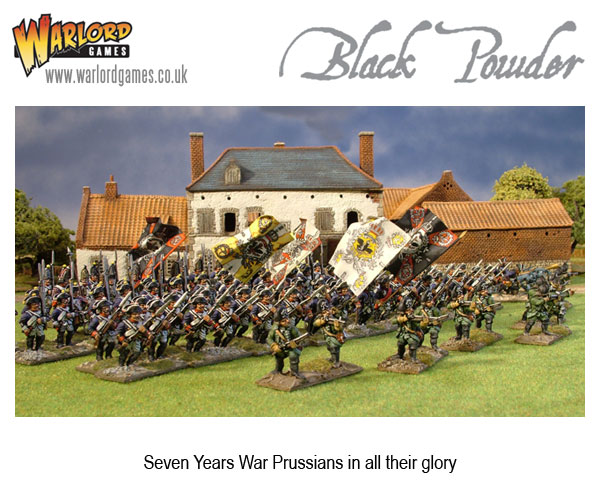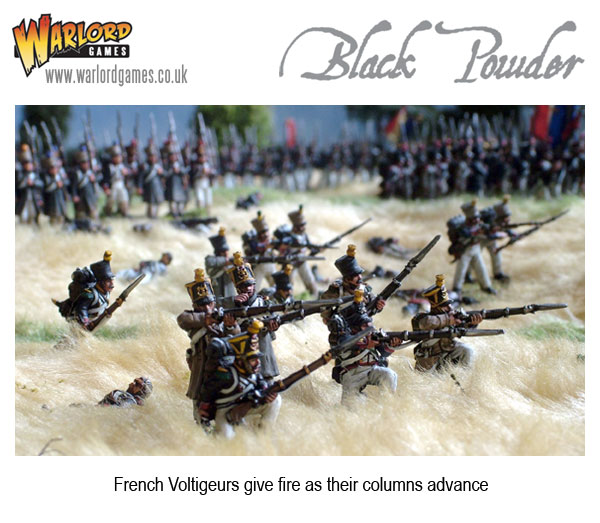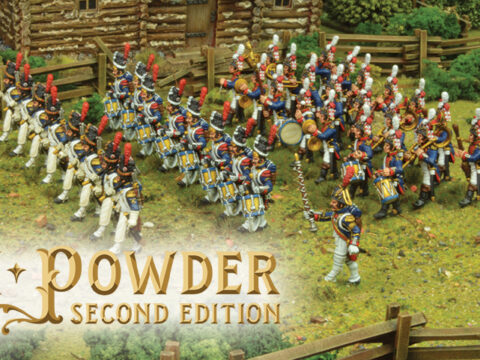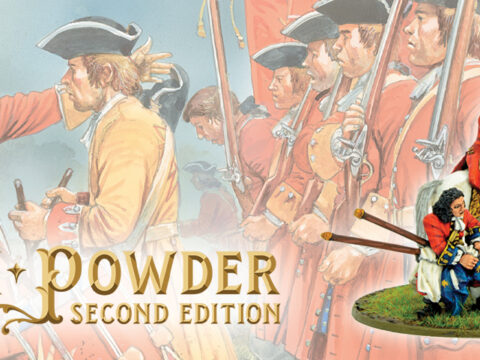In Conversation with Rick Priestley – The Brains Behind Black Powder
Courtesy of Wargames Illustrated Magazine
 Introducing Rick: Rick Priestley is Games Workshop’s creative director and games designer. Not much of a gaming nature passes through the Workshop gates without Rick’s eyes passing over it. He was one of the original designers behind Warhammer, and his credits in the historical theatre include Warhammer Ancient Battles and Warmaster Ancients.
Introducing Rick: Rick Priestley is Games Workshop’s creative director and games designer. Not much of a gaming nature passes through the Workshop gates without Rick’s eyes passing over it. He was one of the original designers behind Warhammer, and his credits in the historical theatre include Warhammer Ancient Battles and Warmaster Ancients.
Wargames Illustrated: Hi Rick, thanks for taking the time to talk to us. I know that Black Powder has been a project which has been bubbling around in the gaming background for some years now, a side project in comparison to your work for Games Workshop and Warhammer Historical, but I get the impression it’s been very much a labour of love…
Rick Priestley: Yes that’s definitely the case. It actually grew up simply by playing games, and the initial idea actually came from Jervis Johnson [Games Workshop stalwart and another acclaimed games designer] with the rule set being written by myself and Jervis. Jervis came up with the original idea for the game. He started out by looking at my Warmaster game and he liked the rapid movement that he got from that, particularly because all the games we played were either round at John Stallard’s, or more commonly round at Alan Perry’s on a big table. Alan Perry’s got a massive collection, so all the games inevitably involved all the table and all the collection because that’s what the Perrys are like; got to shove all the figures on! Often we’d turn up of an evening, gobble a curry, start a game and the two sides would just begin to engage around about midnight by which time my pumpkin was ready outside,. You’ve got work the following day of course, so it was a little frustrating. So Jervis just had this idea to use the Warmaster command and movement system as a way of speeding things up. Because it allows very rapid movement, it allows the narrative of the game to develop within one or two turns and you can get to fight very quickly, yet it still seems very natural and realistic. So that was the start of it; it really was a pragmatic solution.
WI: So it wasn’t a case of spotting a gap in the market for a game of this type?
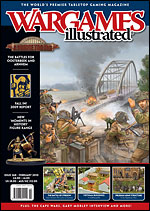 Rick: No, nothing like that. And it was because we started playing it as “the game system” that was just standard round at the Perrys’ when we would be playing Napoleonic or ACW or any comparable period. We just started using it by default, and continued because we enjoyed using it. We largely just made the rules up as we went along to start with because Jervis said, well it’s Warmaster. But because the units are not fixed blocks like they are in Warmaster, we needed to adopt some conventions so we would say, oh this has so many attacks, because in Warmaster each unit has so many attacks, and it has so many shots. So, the standard number of shots for a unit in Black Powder is three, because the standard number of shots for a Warmaster unit is three. So it’s really a make-it-up-as-you-go-along adaption of the Warmaster system into 28mm. And because the twins models are all based in crazy ways, we decided we wouldn’t take models off to represent casualties, instead we would just use casualty markers. Taking models off is a really useful mechanic for a games designer; the minute you start saying that you won’t take models off, you have to start doing quite unusual things. But because the Perrys always use casualty markers (they enjoy having casualties on the battle field and it gives it a very visual quality) we just adopted that as a convention and it grew from there. The whole game developed organically.
Rick: No, nothing like that. And it was because we started playing it as “the game system” that was just standard round at the Perrys’ when we would be playing Napoleonic or ACW or any comparable period. We just started using it by default, and continued because we enjoyed using it. We largely just made the rules up as we went along to start with because Jervis said, well it’s Warmaster. But because the units are not fixed blocks like they are in Warmaster, we needed to adopt some conventions so we would say, oh this has so many attacks, because in Warmaster each unit has so many attacks, and it has so many shots. So, the standard number of shots for a unit in Black Powder is three, because the standard number of shots for a Warmaster unit is three. So it’s really a make-it-up-as-you-go-along adaption of the Warmaster system into 28mm. And because the twins models are all based in crazy ways, we decided we wouldn’t take models off to represent casualties, instead we would just use casualty markers. Taking models off is a really useful mechanic for a games designer; the minute you start saying that you won’t take models off, you have to start doing quite unusual things. But because the Perrys always use casualty markers (they enjoy having casualties on the battle field and it gives it a very visual quality) we just adopted that as a convention and it grew from there. The whole game developed organically.
WI: So you stuck with what worked in Warmaster and if something needed changing you changed it…
Rick: And along the way we changed practically everything, as you do.
WI: This unique approach to basing is both daring and enduring I think, it’s a really welcome aspect of the rules that you don’t have to change the basing on your existing models, an approach that gives an instant appeal to the rules. How did that idea come about?
Rick: It’s because when we play round at John’s he has one basing convention, and we have to cope with that, and when we play round at the Perrys’, it’s another basing convention and sometimes we’ll be using armies from Dave Andrews or Ali Morrison or Tim Adcock’s collection. They are all based in whatever fashion they felt like basing them, so we had to be quite adaptable. It’s really just the footprint of the unit that counts rather than the actual number of figures in it or the way it’s based. There are some things that you do have to bear in mind with variable basing of course. If a unit has got very large bases, it could cover a very broad frontage, which makes its shooting relatively ineffective, because it’s spreading its shots over, say, two feet instead of one foot – we have rules to adapt around that kind of thing. On the whole it’s a game you can play with no bases at all, if you wish, or any style of basing your figures happen to be on.
WI: And that element of casualness with regard to basing, coupled with the lack of a formal points system, helps to add to the friendly aura of the rules.
Rick: It’s interesting because wargaming does tend to split into two camps. There are people who really enjoy the competitive side of wargaming and their social lives become that. And they’re not necessarily hard-nosed, brutal, crazed guys. Most tournament players I have played against have been charming, friendly and helpful. But they have a certain mind set, which is that “I’m here to play a game” and they expect their opponents to have the same mind set. Whereas, I think when we are playing round at Alan Perry’s house, for example, we bring a different mind set to it and I think it’s more typical of the other type of gamer, which is where you actually get together with your friends, specifically to have a social evening in which you’ll push toy soldiers over a table top and create something that’s a piece of theatre. You’re playing as much as you’re gaming. The conversation, and the drink, and the food are all equally important. I love going round to the Perrys’ because just handling the toy soldiers gives me a chance to look at them and admire them; it’s a fantastic thing. They both like the tables to have a strong aesthetic quality; I think Alan Perry’s table tops are the most beautiful wargames table tops I have ever seen. It’s just so appealing when playing games.
I was looking at Alan Perry’s wargaming table only last night on the telly; they repeated Ian Hislop’s programme, and there it was. It reminded me just how much attention the twins pay to what a table looks like. It’s the opposite to that kind of wargame where you turn up with your 1970s 15mm army and some felt shapes to represent woods and buildings.
WI: One of the most striking features for any gamer reading the back cover of the book will be the claim that the rules cover an ambitious 200 years of military history; from 1701 to 1899. Is it really possible to cater for the wars of Marlborough and the Boer Wars in one rule set?
Rick: It’s a problem, but it’s a problem you overcome with specific rules. The way the game is portrayed, it’s quite a big sweep, so you can cope with any type of battle. You’ve got armies moving in battalions, a squadron of cavalry or batteries of artillery all in formal lines. And that’s pretty much the case from the beginning of the 18th century right through until… probably the Franco-Prussian war, to be honest! We took it to 1900 because the Perrys make some Boer War figures, so we did a Boer War game and we found that it worked quite well. We had to adapt some of the formation rules and we had to make changes. But we do that for every period. So, if we were going to play a game based on the Spanish Succession, at the very beginning of the period covered, we would have different rules for manoeuvring the units and formations; these things were less developed in that period.
Napoleonic armies have special rules that allow them to adapt their formations and move in mixed formations. You can tailor the rule set to the period quite easily.
The adaptions are all described in the rule book. They are covered as a series of mechanics and the idea is that whatever period you wish to represent using these rules, you can adopt the mechanic we describe or you can invent your own.
There are different ideas and some work better for games that represent big battles and some work better for games that represent small battles. So it really is a tool kit because that’s what we do… Because we make it up as we go along, applying experience and judgements.
WI: It sounds like a lot of the emphasis of the game is on ‘big table battles’. Would Black Powder work for small table affairs, 6′ x 4′ or smaller?
Rick: You would have to change the movement rates and scale down. It would work mechanically. The reason it really is a big game for a big table is that it is a very visual game and that’s how we play. We don’t play with 15mm figures, to be brutally honest. I have played some games with 10mm figures because it allowed me to test the mechanics and it works very nicely and looks quite good too. You can have such big lines and formations. But in general we play with the armies we have and we are very big fans of 28mm figures. It really is a “this is what we do” set of rules.
WI: How did the manuscript for the rules end up on Warlord Games’ lap?
Rick: John Stallard picked the game up for Warlord because he has been playing as part of our group since the beginning. He said he wanted to publish it which I thought it was very brave, and generous of him, because, as a set of rules, I wasn’t sure how commercially successful they would be. The game has not been written to be commercially successful, it’s been written to be shared.
WI: I think it will be a commercial hit, because the more liberal and ‘light’ approach of Black Powder has a very real and popular appeal.
Rick: It’s written in a fairly entertaining style. The reason I did that is because the mechanics don’t lend themselves to precision. The basic concept of giving a verbal order and then rolling a dice to see to what extent you have accomplished that order is immediately quite woolly. We’ve included certain caveats that make it so that you have to express a certain thing in a certain way, and if you intend a certain thing you have to say a certain thing, but it is still quite woolly really…!
WI: So BP is a game where players declare their intentions before they can carry the action out?
Rick: Yes, and then you roll a dice and you can get 1, 2 or 3 moves to attempt to achieve your aim. Exactly how you interpret those moves is going to be subject to a certain amount of variation, depending on how enthusiastic or optimistic the person making the move is. It’s not a game of chess-like precision and we never felt that necessary. Quite frankly, in the state of inebriation in which we play, it’s always been perfectly adequate!
WI: Something that struck me from the playtest I was involved with was ‘bloody hell, you move fast!’
Rick: It’s one of those things where you have to be a little bit wary. If players are not familiar with the way the game plays they are often inclined to say “I’ll charge ahead at full speed” and they’ll go crazily off and go the whole table length straight into the enemy cavalry. What they are not taking into account is the way that the support and the combat moves work. What happens is their units may do very well on the first turn, but in the next turn, because they are now right in the enemy lines, the enemy close and destroy them. If they had a bit more experience of the game they might have, instead, given an order to cautiously advance with other troops and wait for the rest to catch up. So, I think people who play it for the first time are astonished how far they can move and then astonished how quickly they die. A friend of mine says the quicker you move, the quicker you get into trouble.
WI: Is the speed element of the game born more from gameplay than actual physics/fact?
Rick: It’s not a natural speed they move at. Obviously in reality troops moved with certain limits to their speed, and with tactical movement given most consideration. But when you read actual accounts of battles from the people who were there, you don’t get that sense. What you get is a sense of movement coming as a surprise or troops being misidentified. There’s that element of confusion that gives you a different kind of narrative to a historic battle than if you were looking down on the table like some kind of god. What our rule book tries to replicate is that sense of uncertainty, it must ignore how far a man can move in ten minutes, but it’s entirely consistent with how battles are often described and portrayed.
WI: Getting that element of confusion into wargames rules (which as you say, is so evident in personal accounts of battle) really is the holy grail of rules writing.
Rick: We didn’t want to use successive moves because we didn’t want to spend forever moving units of individually based 28mm soldiers around. So we compounded the move to once, twice or three times, depending on how successful you are. But it’s still got the same idea behind it, which is a variability in the movement. Your ability to move is affected by the proximity of the enemy, so it’s not as if you can go right up to the enemy and then keep moving. What it does mean is that you have slightly unpredictable movement at the stage before the lines close, but as the lines close you get much more predictability. That’s probably more realistic. You have to balance that sense of drama and that narrative with a sense of credibility.
All the people involved with the development of this game are very knowledgeable about their subjects. For example, the Perrys are incredibly knowledgeable about the warfare of the period. When they make models for a period, they do an incredible amount of research including going to museums on the continent, looking at collections. It’s not like they are relying on secondary sources or even things that are common knowledge. John Stallard’s fascination is with personal accounts, so he has any number of copies of contemporary diaries of periods he is interested in. I don’t have that kind of interest in detail. If I start to read, I tend to end up in the politics and the supply and logistics. John would not typically be reading an account of a WWII action at company level, he would be reading the diary account of the captain, I would find myself drawn to how they made that tank, how they designed it and how it was produced. So there is breadth of interest between us.
WI: Black Powder isn’t a novice’s wargame is it ? It couldn’t really be considered an introduction to gaming…
Rick: No, it’s not an introduction to wargaming at all. It’s framed, or presented almost, as if it were though, because it explains everything in a way you would expect it to, it doesn’t take anything for granted and it presents information and mechanisms in a spirit of knowing nothing about wargaming. The truth is it is a slight parody, in so much as it’s a book about gaming presented as a set of wargaming rules. That was the idea anyway.
WI: It’s interesting that Black Powder kicks in almost straight after Warlord’s Pike and Shot figure range ends. Couldn’t you push BP to cover this period?
Rick: The break point is when the battalions start to be armed exclusively with muskets and warfare takes on a characteristic known as ‘linear warfare’. You could push it to battles in the English Civil War but I think that ECW battles have a character of their own. The cavalry have a slightly different role and the artillery have a slightly different role, plus pikes were more heavily involved. If you think of the classic wargames period – ‘horse and musket’ – a phrase quite commonly used, then horse and musket is basically 18th and early 19th century. That’s what Black Powder is; it’s a classic set of horse and musket rules. I think John (Warlord Games) is interested in taking the Black Powder concept and working it for other periods.
WI: And do you think that is viable?
Rick: Yes, I think it is. We have talked about using it for Ancients, although of course there are any number of rules already available for that period. It’s a very muddy pond in which to paddle. We’ve also talked about using it for pike and shot; in fact I think John has already commissioned someone to work on that.
It certainly has potential to be used for other periods, but we have only used it for the periods mentioned on the cover… although we did fight a game in Japan using Samurai, which technically is slightly earlier, but it worked out just fine and it was a very entertaining battle.
WI: Finally, how about the day job? How are things coming on at Games Workshop and more specifically (for our readers) at Warhammer Historical .
Rick: Well I have just helped finish the second edition Warhammer Ancient Battles manuscript. Martin Gibbins has done a very thorough job of bringing the game up to date and all I can say is I don’t think current WAB players will be disappointed! To be honest though Warhammer Historical is more ‘hobby’ than ‘work’. Work is a different think altogether. Speaking of which… I’d better get on with it – plenty of toilets to clean, bins to empty, now where did I leave my mop…?
WI: Ha, ha! Thanks very much Rick.



